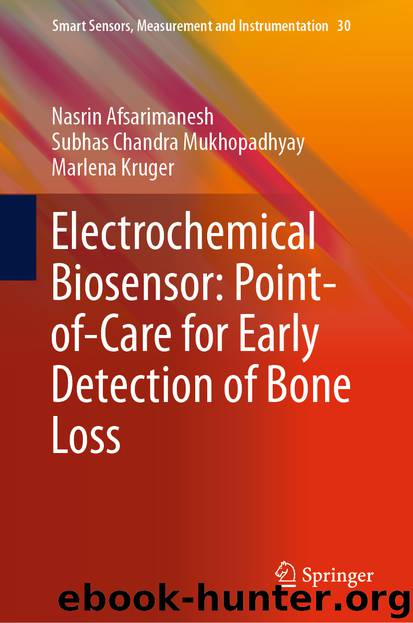Electrochemical Biosensor: Point-of-Care for Early Detection of Bone Loss by Nasrin Afsarimanesh & Subhas Chandra Mukhopadhyay & Marlena Kruger

Author:Nasrin Afsarimanesh & Subhas Chandra Mukhopadhyay & Marlena Kruger
Language: eng
Format: epub
ISBN: 9783030037062
Publisher: Springer International Publishing
4.2 ELISA-Based Experiments
The initial experiments were performed using an ELISA kit in order to get idea about antigen-antibody-based methods. In addition, it was used to validate the results achieved from the developed sensor. As it was discussed in Chap. 2, most of the available methods for the assessment of biochemical markers of bone turnover are ELISA-based. ELISA is an accurate and reliable analytical tool that is generally used in biomedical research for the detection and quantification of a specific molecule in a liquid sample. ELISA can detect the analyte using enzyme-linked antigens and antibodies. Very small quantities of antigens such as hormones, proteins, peptides, or antibodies in a liquid sample can be detected and quantified using ELISA [6, 7].
The antigen in the liquid phase is immobilised into the wells of a 96-well micro-titre plate that links to a primary antibody. A secondary, enzyme-linked antibody then senses the antigen by binding the antigen to the antibody. A chromogenic substrate is used to vary colour in the presence of the antigen. Lastly, the measurement is completed using spectrophotometry technique [8]. Although this technique is a standard immunoassay method, there are some weaknesses in using ELISA; it is a laboratory-based assay that is time-consuming, costly and involves several steps and technical skill. It includes numerous steps and procedures for incubation, antibodies binding and measurements that require not only the services of highly skilled professionals and an expensive laboratory setup but also involves high costs for testing individual samples, and therefore cannot be used for frequent monitoring of CTx-I concentration to monitor variations in bone resorption in an individual.
Download
This site does not store any files on its server. We only index and link to content provided by other sites. Please contact the content providers to delete copyright contents if any and email us, we'll remove relevant links or contents immediately.
| Automotive | Engineering |
| Transportation |
Whiskies Galore by Ian Buxton(41537)
Introduction to Aircraft Design (Cambridge Aerospace Series) by John P. Fielding(32893)
Small Unmanned Fixed-wing Aircraft Design by Andrew J. Keane Andras Sobester James P. Scanlan & András Sóbester & James P. Scanlan(32579)
Craft Beer for the Homebrewer by Michael Agnew(17938)
Turbulence by E. J. Noyes(7708)
The Complete Stick Figure Physics Tutorials by Allen Sarah(7148)
Kaplan MCAT General Chemistry Review by Kaplan(6603)
The Thirst by Nesbo Jo(6444)
Bad Blood by John Carreyrou(6283)
Modelling of Convective Heat and Mass Transfer in Rotating Flows by Igor V. Shevchuk(6230)
Learning SQL by Alan Beaulieu(6041)
Weapons of Math Destruction by Cathy O'Neil(5842)
Man-made Catastrophes and Risk Information Concealment by Dmitry Chernov & Didier Sornette(5659)
Digital Minimalism by Cal Newport;(5396)
Life 3.0: Being Human in the Age of Artificial Intelligence by Tegmark Max(5193)
iGen by Jean M. Twenge(5166)
Secrets of Antigravity Propulsion: Tesla, UFOs, and Classified Aerospace Technology by Ph.D. Paul A. Laviolette(5002)
Design of Trajectory Optimization Approach for Space Maneuver Vehicle Skip Entry Problems by Runqi Chai & Al Savvaris & Antonios Tsourdos & Senchun Chai(4847)
Electronic Devices & Circuits by Jacob Millman & Christos C. Halkias(4752)
